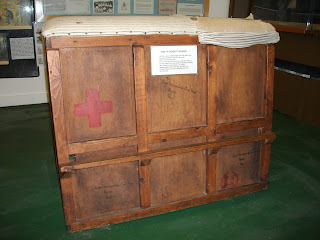Wednesday, April 20, 2011
Previous Posts
- HMS Whitehaven Crew & wartime service
- New Link!
- "Our Olympics" by Harold Drake, R.A.
- "In Affectionate Remembrance"
- Just One Sad and Mysterious Loss
- A Golden Tribute of Hope
- Silent Remembrance
- The War Against Hitlerism
- Salute the Soldier Week campaign, 1944
- The Second World War Gas Mask


1 Comments:
Additional information
The above photograph of the 'Wooden Horse' model used at Stalag Luft III was taken at the Lincolnshire Aviation Heritage Centre (the site of RAF East Kirkby during WW2). This is a half size scale model of the original gymnastic vaulting horse used by POWs that led to three of them making a successful escape in October 1943.
As with the original, this scale model of the 'Wooden Horse' was constructed of the same materials: namely mattress covers, ply wood from Red Cross parcels, bed board slats and corner posts of bunk beds. At Stalag Luft III the accommodation huts of the prisoners had been built 50 - 100 metres away from the perimeter fence to make it more difficult to dig an escape tunnel. Hence the main reason for using a vaulting horse as an escape ploy was to shorten the distance required involved in digging an escape tunnel.
In Greek mythology, the Greek hero Odysseus devised the plan to use the gift of a hollow wooden horse in which men could hide to gain entry into the walled city of Troy. Why, then, not adapt this ancient idea to get men out of the prison camp? Often, the oldest and simplest plans are best and this proved to be the case with the 'Wooden Horse' of WW2. The plan was thought up in 1943 by Flight Lieutenant Eric Williams and approved by the camp's Escape Committee.
The wooden vaulting horse was made and carried out each day to the same spot close the perimeter fence, about 30 metres from the wire. While other prisoners exercised F/Lt Williams and two other POWs (Michael Codner and Oliver Philpot) took it in turns to be carried inside the vaulting horse where they would enter a trap door and dig out the tunnel. According to the IWM it took 114 days to dig the tunnel underneath the fence and finally made their escape on 29 October 1943.
It was one thing to get out of a prison camp in WW2. It was another thing making a successful escape back home. Stalag Luft III was located near Sagan in eastern Germany and over 600 km from Switzerland and almost 300 km from the Baltic ports that led to neutral Sweden. These distances made a successful "home run" even more difficult for any potential escapee. As it turned out, the three POWs who escaped as a result of the 'Wooden Horse' attempt all made it to neutral Sweden. From there they were repatriated back to the UK.
--------------------
The Lincolnshire Aviation Heritage Centre (RAF East Kirkby) has an excellent collection of information, photographs and memorabilia on escape attempts by RAF POWs during WW2. The scale model of the WW2 'Wooden Horse' forms just a small part of the display The Imperial War Museum, London has an even bigger display dedicated to WW2 escapees, including much of the original material of the 'Wooden Horse' escape kit. Both these exhibits are well worth a visit to learn about an important part, if little known, of the war.
Written accounts of the 'Wooden Horse' escape were published by two of the escapees: 'The Wooden Horse' by Eric Williams (1949) and 'Stolen Journey' by Oliver Philpot (1950). The book by Eric Williams was also adapted in 1950 as a film (also called 'The Wooden Horse'). In 1963 another film was released about an escape attempt from Stalag Luft III: 'The Great Escape' based on a book by Paul Brickhill. Although based on real events, as with many films about WW2, some of the names, characters and events depicted in the films are in fact fictional.
---------------------
Post a Comment
<< Home